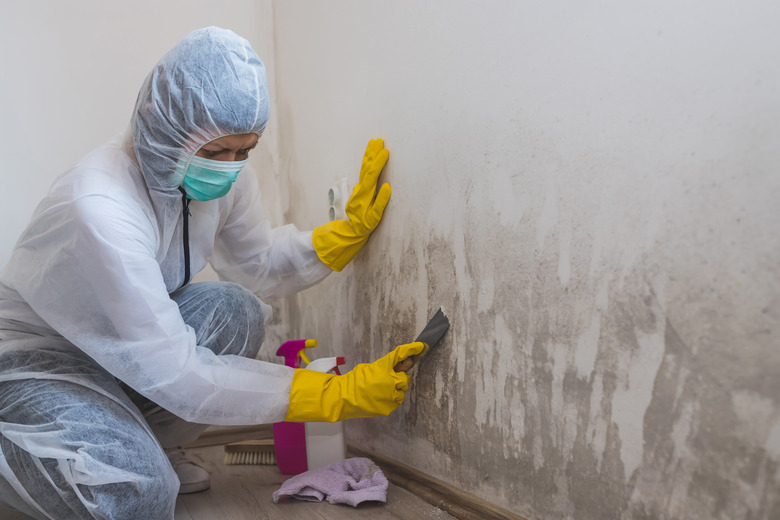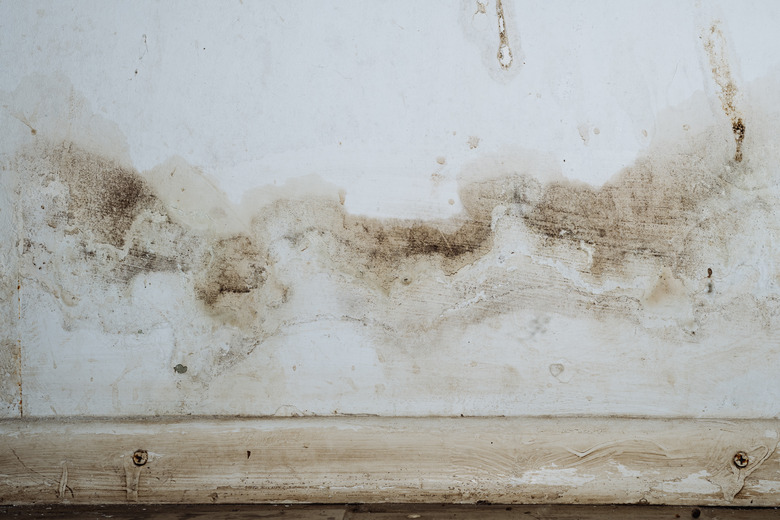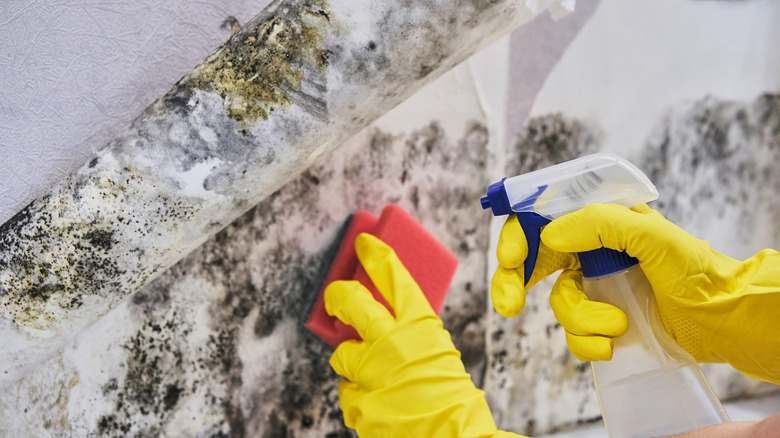Professional Mold Remediation: Everything You Should Know
We may receive a commission on purchases made from links.
It's every homeowner's worst nightmare — flooding or major water damage, resulting in squishy sofas, sloppy carpets and mold left behind on the drywall. Even if you empty and dry out the space with a dehumidifier once the inflow of water stops, mold remediation (or the removal, cleaning and disinfection of moldy areas) takes priority since this subtle substance grows behind walls and paneling, beneath carpets and in other affected areas where it easily goes unnoticed. Since mold is a potential health hazard, after major leaks or even minor floods, it's wise to hire professionals to assess the situation, determine the extent of the damage and come up with a remediation plan.
Signs of Mold
Signs of Mold
The most obvious indication of mold in your home is actually seeing it in places such as on a wall, on a carpet after flooding or on a ceiling after a plumbing leak. A musty mildew odor that doesn't go away is another probable sign of mold. If you live in a humid area where rooms often smell musty, there may be enough indoor humidity to cause unseen mold. Any signs of moisture or dampness on walls, wood or other surfaces where water seems abnormal are also clues that conditions are right for mold growth, as mold needs moisture to thrive.
When to Test for Mold
When to Test for Mold
Not every leak leads to a mold problem, however. A one-time pipe leak that was repaired right away generally isn't a cause for concern, as the source of moisture has been eliminated. If you find that a pipe or your roof has been leaking for an unknown amount of time or if you see signs of mold damage, such as large black areas when repairing walls or flooring in your house, a mold test is a good idea. At the very least, the mold should be removed.
Not all mold is problematic, but if anyone in your home has respiratory or other health problems that could be aggravated or caused by mold, it's a good idea to get a mold test. (And, even mold allergens can become quite the nuisance, even if you can tolerate it.) If your home already needs mold remediation services in one area, it's a good idea to test for mold in other areas as well.
Every Home Has Mold Spores
Every Home Has Mold Spores
Mold spores exist in every home and indoor space, as mold spores are also present in outdoor air. While there is no set standard for a particular number of mold spores indoors to indicate a serious problem, any reading that seems hundreds or thousands times higher than the outdoor air mold spore totals for your area on the same day is cause for concern. Readings for mold spores in the air of a room taken in the exact same spot even one hour apart may vary greatly, as simply walking in the room may kick up some spores from the floor.
Types of Mold Testing
Types of Mold Testing
Some mold tests simply indicate whether mold is present, but they don't necessarily indicate the variety of the mold. The simplest tests are done by pressing clear tape over the suspected mold and then sticking that onto a clear plastic bag and sending it to a lab for testing. These tests do not require a professional.
More intensive tests use special equipment operated by a professional to sample the air for mold spores and then compare the readings of indoor and outdoor air or one room with suspected mold problems to another room in the house. These mold inspections read the concentration of spores in the air, with any unexpectedly high concentration indicating a likely mold issue. Some of them also show how many different types of mold are present, what they are and which have the highest concentrations, which can be helpful if anyone in the home is allergic to specific mold types.
Mold Remediation Plan
Mold Remediation Plan
If testing uncovers a considerable mold problem, hire a professional who is trained in mold remediation. A pro has the skill set and knows proper safety procedures to get rid of the mold. A mold removal company generally writes up an action plan that documents the extent of the issue and then details which areas the workers need to isolate to contain the contamination.
During remediation, workers remove all wet or damaged materials and then clean nonporous surfaces and furnishings (generally with an antimicrobial treatment). Furniture and other home goods may be carted outdoors or to another area for cleaning. This also ensures that the floor and other areas in the affected room can be thoroughly treated without objects in the way.
At a designated time after job completion, a representative of the mold removal company returns to ensure the area is still clean and mold-free. This ensures that potential long-term problems, such as excessive humidity or leaky pipes, have been properly repaired. If you wish, feel free to hire a mold inspector at some point afterward as well, as a nonaffiliated inspector may catch something the original firm overlooked.
Finding a Mold Remediation Pro
Finding a Mold Remediation Pro
When you've experienced flooding or major water damage in your home, you might be desperate to hire someone right away — and unfortunately sneaky scammers can take this vulnerability and run with it. Thi is why it's so important to research reputable mold removal firms before choosing one. Look for flood restoration and cleaning companies that have employees who are trained and licensed to test for and remove mold. Some states even require such licensing for all mold remediation companies. This information can be found via Environmental Protection Agency links to each state's resources.
A reputable company generally offers a free assessment of the mold situation in a home but be sure to ask this before setting up an appointment to ensure there are no charges. Also ask if the company has pollution liability insurance and whether the work is guaranteed. Ask to see the terms of the guarantee to know just what's covered in case they don't do a satisfactory job, as a good company should offer to correct the issue if the first time around doesn't do the trick.
Other good questions to ask include what type of mold testing is done and whether the team isolates the area while cleaning. Isolation is extremely important to keep the mold out of other areas of your home. The company's crew should also wear protective gear when doing this work. Find reputable companies by reading local reviews and by asking in neighborhood social media groups, as there's a good chance that someone fairly close to you has hired one of the companies before. A company that's been in business for a while may have pictures of before and after work online. Its representatives should also be able to give a thorough rundown of the type of work involved in a mold situation similar to the one in your home.
Restoration After Mold Removal
Restoration After Mold Removal
In many cases, after a severe mold problem, stains remain visible even after the area has been cleaned and removed. If you are dealing with an area that had been submerged in floodwater or wastewater, the carpet and padding that was removed for cleanup must be discarded, as they're probably damaged beyond the point of reuse. Washable items, such as some area rugs, may be salvageable.
You may choose to hire a separate contractor after mold remediation to replace or rebuild items removed during the remediation process, such as portions of walls, ceilings and flooring materials. Read your homeowners' insurance policy to determine whether flood-related damages and losses are covered. If you live in an area known for flooding, the standard policy may not fully cover flood damage, but add-on flood coverage is available. Some insurance policies cover mold remediation or inspection as well, but this varies greatly from one policy to the next.


